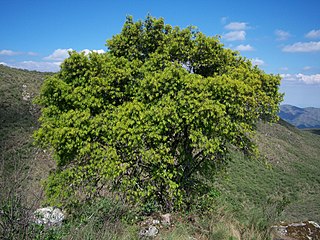
Podocarpus latifolius is a large evergreen tree up to 35 m high and 3 m trunk diameter, in the conifer family Podocarpaceae; it is the type species of the genus Podocarpus.

Podocarpus totara is a species of podocarp tree endemic to New Zealand. It grows throughout the North Island and northeastern South Island in lowland, montane and lower subalpine forest at elevations of up to 600 m.

Prumnopitys taxifolia, the mataī or black pine, is an endemic New Zealand coniferous tree that grows on the North Island and South Island. It also occurs on Stewart Island/Rakiura but is uncommon there.

Podocarpus is a genus of conifers, the most numerous and widely distributed of the podocarp family, the Podocarpaceae. Podocarpus species are evergreen shrubs or trees, usually from 1 to 25 m tall, known to reach 40 m (130 ft) at times. The cones have two to five fused cone scales, which form a fleshy, berry-like, brightly coloured receptacle at maturity. The fleshy cones attract birds, which then eat the cones and disperse the seeds in their droppings. About 97 to 107 species are placed in the genus depending on the circumscription of the species.

Podocarpus lawrencei is a species of podocarp native throughout the Australian high country, from southern Tasmania through to the New South Wales highlands. Common names are Errinundra plum-pine and mountain plum-pine. It grows on exposed sites to 1,800 m, often forming living carpets over rocks through wind pruning.

Podocarpus drouynianus is a species of podocarp native to the relatively high rainfall southwestern corner of Western Australia, where it is known by the name emu berry, wild plum or native plum although it is not a true plum. The Noongar name for the plant is koolah.

Podocarpus nubigenus is a species of podocarp, endemic to the Valdivian temperate rain forests of southern Chile and adjacent southwestern Argentina. It is the southernmost podocarp in the world. It grows from 38°S to Ultima Esperanza (53°S), in wet and swampy soils. It can settle clear grounds, with a faster growth than the other Chilean Podocarpaceae.

Podocarpus elatus, known as the plum pine, the brown pine or the Illawarra plum, is a species of Podocarpus endemic to the east coast of Australia, in eastern New South Wales and eastern Queensland.

Podocarpus angustifolius is a species of conifer in the family Podocarpaceae. It is endemic to Cuba.
Podocarpus aracensis is a species of conifer in the family Podocarpaceae. It is found only in Brazil.
Podocarpus brasiliensis is a species of conifer in the family Podocarpaceae. It is found in Brazil and Venezuela.
Podocarpus celatus is a species of conifer in the family Podocarpaceae. It is found in the Amazon rainforest.

Podocarpus laetus is a species of conifer in the family Podocarpaceae, commonly known as Hall's tōtara, mountain tōtara or thin-barked tōtara. Previously known as Podocarpus hallii and Podocarpus cunninghamii, in 2015 it was realised that the much earlier name P. laetus has priority. Its common name results from the species being named after J. W. Hall, a New Zealand pharmacist.

Podocarpus elongatus, the Breede River yellowwood, is a species of conifer in the family Podocarpaceae. In contrast to other yellowwood species of southern Africa, Podocarpus elongatus often resembles an enormous, round, multi-stemmed bush in its habit. The Breede River yellowwood is a protected tree in South Africa.
Podocarpus guatemalensis is a species of conifer in the family Podocarpaceae. Its common names include ocotillo de llano, cypress de montaña, cipresillo, alfajillo, pinillo, palo de oro, and piño de montaña.

Podocarpus parlatorei is a species of tree in the family Podocarpaceae and native to Argentina and Bolivia, where it grows on steep hillsides on the eastern flanks of the Andes. It has been harvested commercially in the past but is now protected under a CITES treaty. The International Union for Conservation of Nature has assessed its status as being "near threatened".
Podocarpus perrieri is a species of conifer in the family Podocarpaceae. It is found only in Madagascar.

Podocarpus salignus, the willow-leaf podocarp, is a species of coniferous evergreen tree in the family Podocarpaceae. It is found only in Chile, from 35 to 42° south latitude, where it is threatened by habitat loss. Growing up to 20 m (66 ft) in height and 1 m (3 ft) in diameter, the trunk is straight and cylindrical, with reddish-gray bark. The arching branches bear long, narrow, willow-like leaves, and red fleshy oval fruits where male and female plants are grown together. In Chile it is known as Mañío de hojas largas (long-leaved).
Podocarpus transiens is a species of conifer in the family Podocarpaceae. It is found only in Brazil.
Manilkara rufula is a species of tree in the Sapodilla family. It is endemic to the northeastern submontane forests of Bahia, Sergipe, Pernambuco, Paraíba, Ceará and Piauí states of Brazil. Although this species exists in many places, where it occurs it is either not numerous, or its numbers are declining due to loss of habitat.















